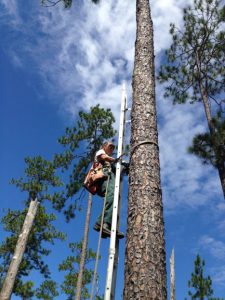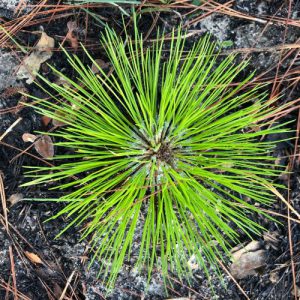
A biologist with Blackwater State Forest checks longleaf pines for signs of red cockaded woodpecker nests. Photo credit: Carrie Stevenson, UF IFAS Extension
Longleaf pine is a granddaddy among the trees of the Southeastern United States, once covering up to 90 million acres throughout the coastal plain. Tall and stately, slow-growing and dense, it was one of the most desirable trees in the forestry and shipbuilding industry for two centuries. Its sap was used to produce turpentine, tar, and pitch, especially to coat and waterproof the bottoms of wooden ships. Its tall, upright form made for a perfect ship’s mast. Between the years 1830 and 1935, approximately 90% of the Southeast’s old growth longleaf trees were harvested, and much of the land was used for farming or development.
Besides its commercial uses, the longleaf ecosystem supports a wide diversity of other plants and animals. The endangered red-cockaded woodpecker nests only in the wood of old (100-500 years!) longleaf pines, and the canopy shades a grassy groundcover often dominated by wiregrass. Gopher tortoises, the endangered indigo snake, and quail also thrive in longleaf pine ecosystems.
The longleaf pine is highly adapted to fire while in its “grass” stage and as an older tree, allowing it to tower over smaller hardwoods that are cleared out in natural and prescribed fires. This clearing allows its own seeds to sprout and thrive, and for low-growing grasses to dominate the understory. Pines can be difficult to differentiate in the southern forest, but longleaf pines have deep (up to 8-12 feet) taproots and long needles—up to 18 inches—in fascicles of two or three. The needles grow in spherical bunches that look like cheerleading pom poms.
As ecologists and foresters have realized the important role these trees play in the landscape, significant efforts have been undertaken to restore much of that habitat on both public and private land. Locally, Blackwater State Forest and neighboring Eglin Air Force Base have replanted and managed thousands of acres of longleaf habitat. Foresters and nonprofits also work with private landowners to reestablish these stately pines.
- Green Anoles - July 11, 2025
- The Praying Mantis - June 20, 2025
- Bluebirds in Florida - May 8, 2025

